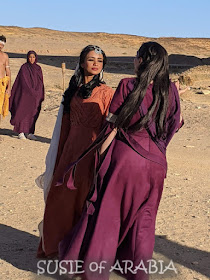At this year's Winter at Tantora Festival, a cast of about 60 local actors, as well as several camels and goats, performed a live theater production outdoors, in a natural setting in front of the sandstone outcroppings with carved tombs from the ancient Nabataean people. The festival has provided many opportunities and employment for the citizens of Al Ula, which has a population of a little over 5,000.
The acting, costumes, and script were an enjoyable and interesting reenactment of life in those times, complete with chanting, rivalry, a battle, and loss. It was actually rather exciting to see this type of live entertainment here in Saudi Arabia.
Al Ula, located in northwestern Saudi Arabia, is a city rich in history, culture, breathtaking scenery, and fertile valley of farmlands. Two thousand years ago, it was an important location for the ancient Nabataean civilization, a thriving oasis with underground springs as well as a burgeoning trade center along the incense caravan route.
Al Ula was known as Hegra back then. It was the southern capital of the Nabataean empire, while Petra in Jordan was the main capital in the north. Al Ula is located at the halfway point between Petra and Mecca, the most important city in Islam, making it the perfect stop for the caravan trade route.
Madein Saleh is the name of the area of Al Ula where the Nabataeans carved hundreds of tombs into the enormous sandstone rocks. Some Muslims believe that the entire area is cursed because the ancient peoples living there worshiped idols and that Allah punished them with a deadly earthquake and severe lightning. Indeed still today, there are many Muslims around Saudi Arabia who will not set foot in that region because of their belief that it is cursed, even though most of Al Ula's residents are Muslims.
Because of its fascinating landscape, rich history, and archaeological importance, Al Ula has been chosen by the government to be a key focus for the development of one of Saudi Arabia's newest industries - tourism. In a few short years, the area anticipates upwards of two million visitors from around the world each year.








Your second shot particularly stands out.
ReplyDelete